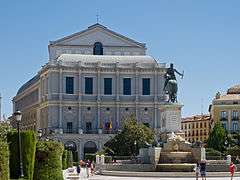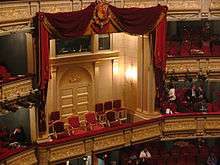Teatro Real
Teatro Real (Royal Theatre) or simply El Real, as it is known colloquially, is a major opera house located in Madrid.[1][2] Founded in 1818 and inaugurated on 19 November 1850, it closed in 1925 and reopened in 1966. Beginning in 1988 it underwent major refurbishing and renovation works and finally reopened in 1997 with a capacity of 1,746 seats. Today the Teatro Real opera is one of the great theaters of Europe hosting large productions involving leading international figures in opera singing, musical direction, stage direction and dance. The theater offers visitors guided tours in several languages, including the auditorium, stage, workshops and rehearsal rooms.
| Teatro Real de Madrid | |
|---|---|
 | |
| Location | Madrid, Spain |
| Coordinates | 40°25′06″N 3°42′37″W |
| Area | Plaza Isabel II, s/n |
| Built | 1818–1850 |
| Rebuilt | 1991–1997 Jaime González Varcárcel Miguel Verdú Belmonte Francisco R. Partearroyo |
| Architect | Antonio López Aguado Custodio Moreno |
| Official name: Teatro Real de Madrid | |
| Type | Non-movable |
| Criteria | Monument |
| Designated | 1993 |
| Reference no. | RI-51-0008289 |
 Location of Teatro Real de Madrid in Spain | |
_an_der_Plaza_de_Isabel_II_in_Madrid_Spanien_-_Foto_Wolfgang_Pehlemann_P1150196.jpg)
History
Founded by King Ferdinand VII in 1818, and after thirty-two years of planning and construction, a Royal Order on 7 May 1850, decreed the immediate completion of the "Teatro de Oriente" and the building works were finished within five months. The Opera House, located just in front of the Palacio Real, the official residence of the Queen who ordered the construction of the theatre, Isabel II, was finally inaugurated on 19 November 1850, with Donizetti's La favorite.[2]
The Teatro soon became one of the most prestigious opera houses in Europe. For over five decades it hosted the most renowned singers and composers of the time. In the early period, it saw famous opera singers such as Alboni, Frezzolini, Marietta Gazzaniga, Rosina Penco, Giulia Grisi, Gio Ronconi, Italo Gardoni, Mario de Candia and Antonio Selva among many others. In 1863, Giuseppe Verdi visited the theatre for the Spanish premiere of his La forza del destino. At its peak, in the last quarter of the 19th century, the Teatro hosted world renowned artists such as Adela Borghi, Marie Sasse, Adelina Patti, Christina Nilsson, Luisa Tetrazzini, Mattia Battistini, Julián Gayarre, Angelo Masini, Francesco Tamagno and Enrico Tamberlick. In 1925, the Ballets Russes of Diaghilev performed in the theatre with the presence of Nijinsky and Stravinsky.[2][3][4]
From 1867 to 1925 the Teatro Real also housed the Madrid Royal Conservatory. In December 1925 a Royal Order ordered its activities to be discontinued owing to the damage that the construction of the Metro de Madrid had caused to the building. The government set out to restore it and ordered numerous projects to be drawn out for its renovation, such as that from architect Urdanpilleta Flórez, who proposed a monumental remodeling of the building. However, financial difficulties prevented the completion of these projects and led to a simple restoration, sponsored by the Juan March Institute, and carried out first by the architect Manuel Gonzalez Valcárcel, and later by architects Miguel Verdú Belmonte and Francisco Rodriguez Partearroyo.[5][6]
The theatre reopened in 1966 as a concert hall as well as the main concert venue for the Spanish National Orchestra and the RTVE Symphony Orchestra. The reopening was celebrated with a concert of the Spanish National Orchestra conducted by Rafael Frühbeck de Burgos, and the Orfeón Donostiarra. In 1969, the 14th Eurovision Song Contest was held at the theatre, featuring an onstage metal sculpture created by surrealist Spanish artist Salvador Dalí.[2][4]
Remodeling

In the 1990s, the house was remodeled to host opera again. The building was completed in late 1995, then the process of technical, administrative, artistic and functional organization began which led to the opening of the theatre in 1997. The remodeling was based on the old classical style of opera house with only basic modernization leaving many seats without a view of the stage. A considerable percentage of seats have a limited or zero view of the stage and a live stream of operas and ballets is projected on the upper side walls of the house so that the entire audience can follow the performance regardless of their view of the stage.
The first opera program performed for the reopening was Manuel de Falla’s El sombrero de tres picos and La vida breve, which was immediately followed by the world premiere of Spanish composer Antón García Abril's Divinas Palabras (actually commissioned to open the house) with Plácido Domingo in the cast.[4] The company staged the first modern revival of Vicente Martín y Soler's Il burbero di buon cuore in 2007, and the world premiere of Philip Glass' opera The Perfect American in 2013.
Productions
The theatre stages around seventeen opera titles (both own productions and co-productions with other major opera houses in Europe and South America) per year, as well as two or three major ballets and several recitals, from September to July.[2]
The most popular operas at the Teatro Real have included Verdi's Rigoletto (given 387 performances), followed by Aida with 361 and Il trovatore with 342. Two works by Meyerbeer L'Africaine (with 268) and Les Huguenots (with 243) have been shown to draw audiences, although the former work has not been performed since the 1920s, being no longer considered mainstream repertory. Donizetti's Lucrezia Borgia has been given some 218 performances since its debut in the house in 1919.
Bicentenary
The Teatro Real celebrated its bicentenary with a special programme from 2016 through 2018. One of the operas featured was Bellini's I puritani, a co-production with the Teatro Municipal of Santiago, Chile. A performance of this work was streamed in July 2016 via the Teatro Real's Facebook page,[7] an example of the theatre extending its reach by digital services. The event was also relayed to a number of venues and was a national trending topic on Twitter. The same production has been performed by the company (including orchestra and chorus) on August 2017 at the Savonlinna Opera Festival.
For the 2017/18 Season (20 years from the reopening), some of the most popular opera titles on the Theatre's history were scheduled: Bizet's Carmen, Puccini's La bohème, Donizetti's Lucia di Lammermoor and Verdi's Aida, alongside rare operas such as Zimmermann's Die Soldaten and Britten's Gloriana.
Company
The orchestra of the Teatro Real is the Orquesta Sinfónica de Madrid. The current artistic manager is Joan Matabosch, former director of Gran Teatre del Liceu in Barcelona. From 2015, the Music Director is the British conductor Ivor Bolton, and Pablo Heras-Casado is Principal Guest Conductor.
Tours of the building
The Opera House offers daily different types of guided tours, lasting between 50 and 90 minutes and given in various languages. This gives the public the opportunity to learn about the building, including the stage area, the workshops and the rehearsal spaces.[8]
Artistic directors (from 1995)
|
Music directors (from 1997)
|
See also
References
- "Teatro Real". Time Out Madrid. Archived from the original on 2009-09-05. Retrieved 2020-07-25.
- "Teatro Real, Madrid's premier opera house". gomadrid.com. Retrieved 2009-10-22.
- "Teatro Real de Madrid" (in Spanish). Archived from the original on 2008-10-14. Retrieved 2009-01-31.
- "Cultural Institutions: Teatro Real". esMADRID.com. Retrieved 2009-09-03.
- Herrero, Maira; Partearroyo, Francisco Rodríguez de; Mora, Domi (1998). El Teatro Real. ISBN 978-8477825203.
- El Teatro Real de Madrid: teatro de la ópera. 1996. ISBN 978-8489365728.
- "La ópera "I puritani" se retransmitirá en directo en Facebook". ABC. 13 July 2016. Retrieved 25 July 2020.
- Guided tour information Teatro Real. (in Spanish & English) Retrieved 25 July 2020.
- "Ivor Bolton, nombrado nuevo director musical del Teatro Real" [Ivor Bolton appointed new musical director of the Teatro Real]. El Arte de la Fuga (in Spanish). 10 February 2014. Archived from the original on 22 February 2014. Retrieved 25 July 2020.
- "The Board of Directors of the Teatro Real appoints Ivor Bolton as Music Director" (Press release). Teatro Real. 10 February 2014. Retrieved 25 July 2020.
External links
| Wikimedia Commons has media related to Teatro Real. |
| Preceded by Royal Albert Hall London |
Eurovision Song Contest Venue 1969 |
Succeeded by RAI Congrescentrum Amsterdam |